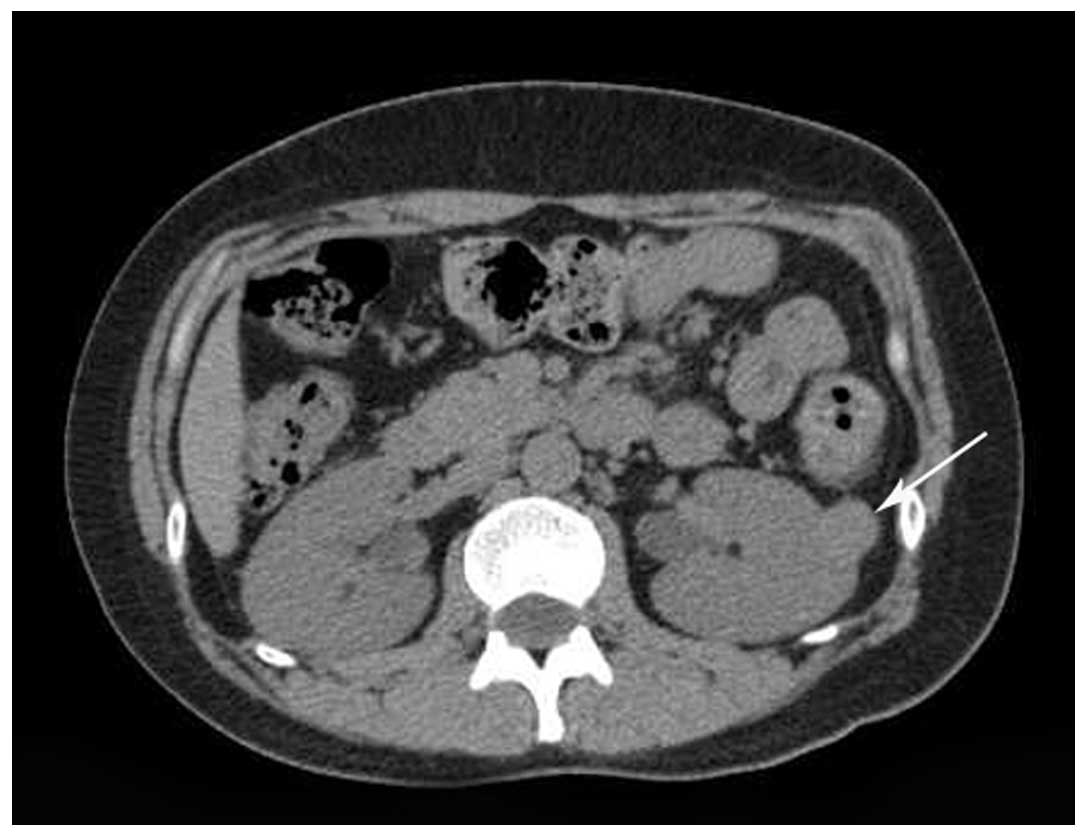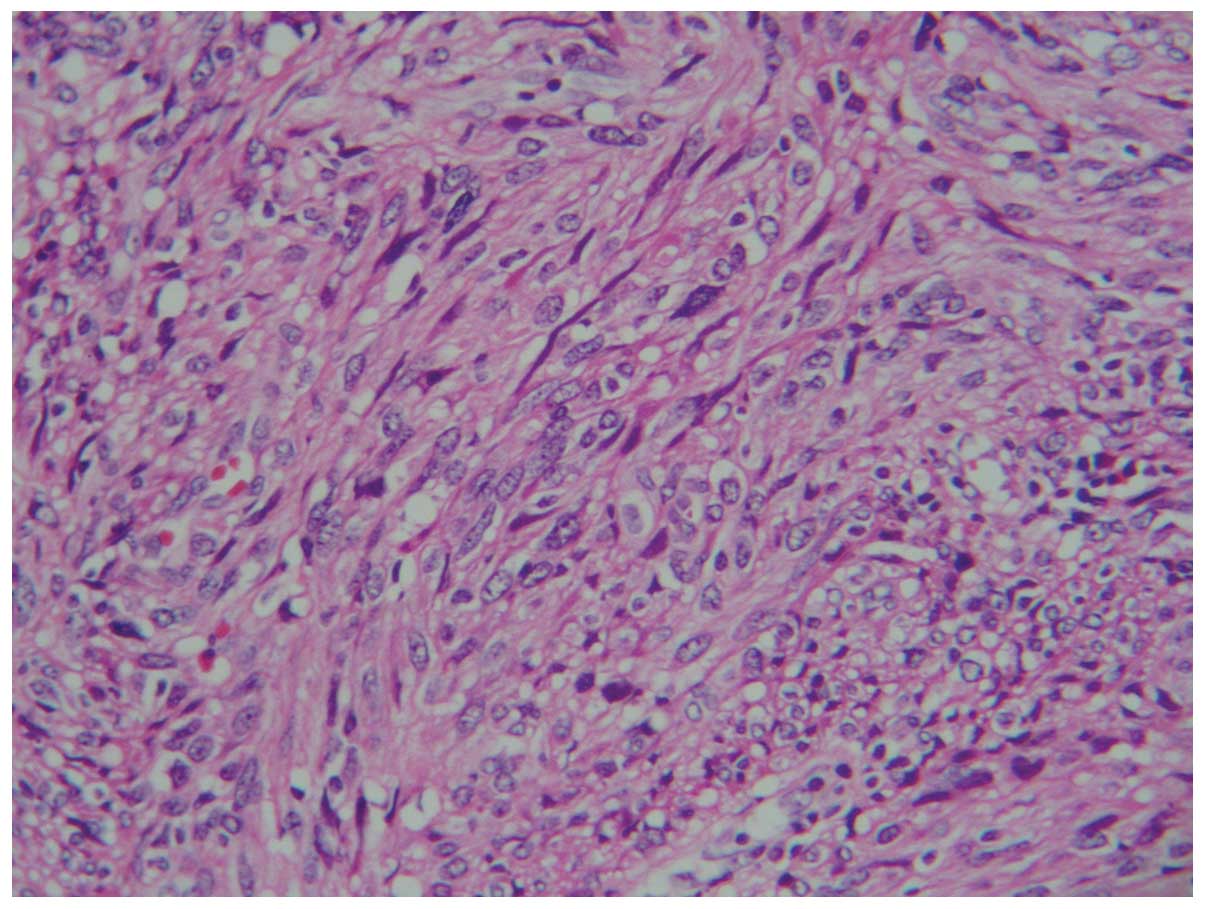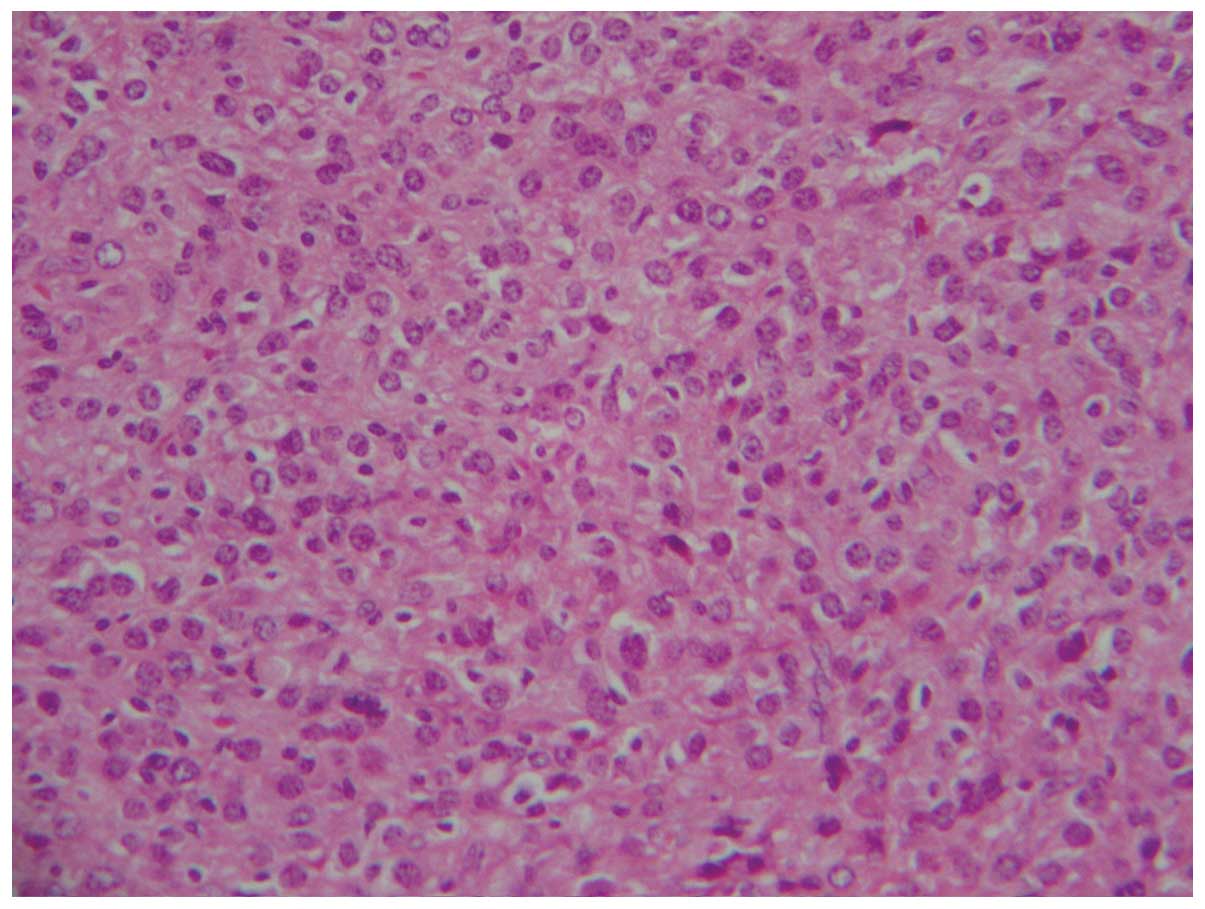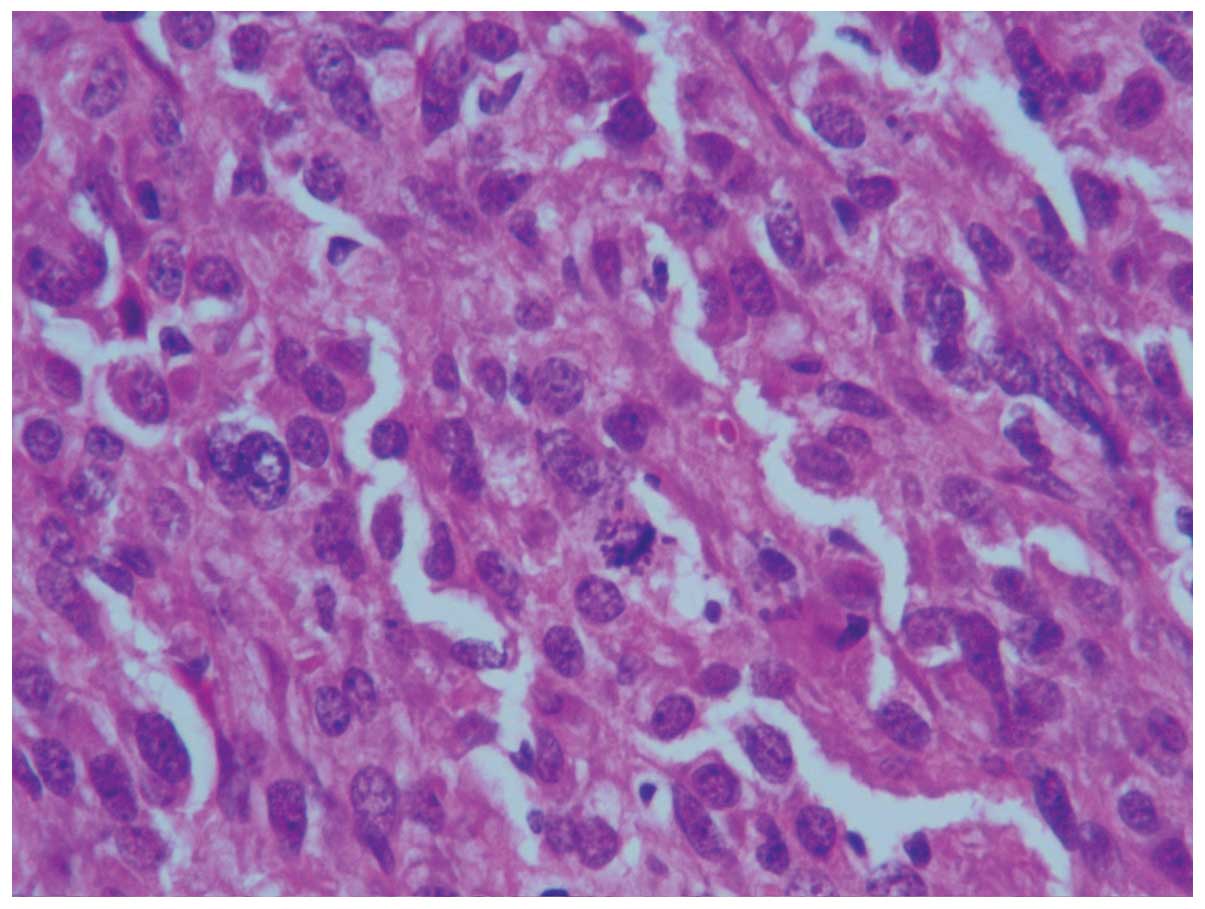Juxtaglomerular cell tumor: A case report
- Authors:
- Published online on: December 21, 2015 https://doi.org/10.3892/ol.2015.4041
- Pages: 1418-1420
Abstract
Introduction
A juxtaglomerular cell tumor (JGCT) is an extremely rare, benign renal neoplasm of myoendocrine cell origin (1) that was first described by Kihara et al in 1968 (2). To date, ~100 cases of JGCT have been reported (3–13), however, few studies have systematically summarized its characteristic manifestations on computed tomography (CT) and magnetic resonance imaging (MRI) (4,5). JGCT is characterized by renin production, hypokalemia and hypertension (5). Therefore, clinical features have assistant value for an accurate diagnosis. The diagnosis relies on pathological identification. The present study reports the case of a 29-year-old female who underwent a long process for the confirmation of a JGCT. Written informed consent was obtained from the patient.
Case report
A 29-year-old female presented to the Outpatient Clinic of The Central Hospital of Lishui (Lishui, Zhejiang, China) on April 15, 2013, due to headaches and hypertension.
The patient suffered from recurrent headaches and reported a two-year history of hypertension. The patient had previously been prescribed Norvasc, which effectively controlled the blood pressure. Furthermore, in April 2012, the patient was admitted to The First Affiliated Hospital of Zhejiang University (Hangzhou, China) with hypertension and subsequently underwent contrast-enhanced (CE)-CT, which found a left renal neoplasm. However, due to a lack of tumor-related symptoms, no further diagnosis was made and no treatment was provided.
Upon admission to The Central Hospital of Lishui in April 2013, physical examinations showed no abnormal findings, but hypokalemia was noted (potassium, 3.22 mmol/l; normal range, 3.5–5.5 mmol/l). The patient's blood pressure was 140/100 mmHg. Renal function, urinalysis, and other chemical and hematological profiles showed no abnormalities, with the exception of increased peripheral plasma renin activity (32 pg/ml/h; normal range, 0.3–2.9 pg/ml/h) and a high aldosterone level (324.65 pg/ml; normal range, 10–160 pg/ml).
Abdominal US revealed a low echo solid mass measuring 2.2×1.8 cm in the left kidney. Unenhanced CT revealed a clearly demarcated isodensity lesion in the upper-middle region of the left kidney (Fig. 1). CE-CT demonstrated that the tumor was not markedly enhanced in the corticomedullary phase, but that it was further enhanced in the parenchymal phase and that the density slightly decreased in the excretory phase (Fig. 2). CT angiography (CTA) revealed the mass and normal renal vessels. The patient did not undergo MRI.
A retroperitoneoscopic left nephrectomy was performed on April 30, 2013. Grossly, a well-demarcated mass of 2.2×1.8×1.5 cm in size was located in the left kidney. Microscopic examination revealed that the tumor was composed of spindle cells (Fig. 3) with well-defined cell membranes. Polygonal cells (Fig. 4) with abundant eosinophilic cytoplasm, indistinct cell borders and nuclear atypia were observed (Fig. 5). Immunohistochemical findings: Vimentin (+), cluster of differentiation (CD)34 (++), B-cell lymphoma 2 (−/+), CD99 (−/+), CD117 (−/+), Dog-1 (−), human melanoma black 45 (−), Melan-A (−), S-100 (−), cytokeratin (−), epithelial membrane antigen (−), Synaptophysin (Syn; +), CD56 (−), smooth muscle actin (−/+) and Desmin (−), with a Ki-67 of 6–8%. The diagnosis was of a solitary fibrous tumor (SFT). Consultation with pathologists from other hospitals resulted in five pathologists agreeing with this diagnosis, while three other pathologists suggested a diagnosis of an undifferentiated sarcoma, sarcomatoid carcinoma or mesoblastic nephroma. Finally, the diagnosis of JGCT was formed due to the following factors: Young female patient; hypertension, hypokalemia and elevated plasma renin activity; histological morphology; positivity for CD34 and Syn; and post-operative normal blood pressure and plasma renin activity. The patient was followed up for 2 years and 6 months, with no evidence of tumor recurrence.
Discussion
JGCT mostly affects young adults. The peak age of incidence is in the second and third decades, with a 2:1 female preponderance (5). Although a JGCT is generally considered to be a benign tumor, one metastatic tumor has been reported (6). Therefore, an early diagnosis and surgery is necessary. In the present study, a case of a JGCT is reported and the significance of clinical characteristics for the pathological diagnosis of a JGCT is discussed.
The majority of JGCT patients exhibit a clinically typical presentation, including hypertension, hyperreninemia, hyperaldosteronism and hypokalemia (5). In the present study, hypertension was the first and most prominent manifestation, and the main reason for attendance at hospital, which is consistent with previously reported cases (7). Although one case of non-functioning JGCT has also been reported (8), the clinical features are still important for a definite diagnosis. No correlation has been found between the severity of symptoms and the size of the tumor (7).
Thus far, the US features of JGCT have not been reported. The majority of JGCTs reported in the literature are low- or isodensity, well-circumscribed, cortical tumors on plain CT scanning (7,9), which is consistent with the findings of the current study. Despite being hypervascular, the tumor appears hypovascular on CE-CT and CE-MRI, possibly due to renin-induced vasoconstriction (4). None of the reported JGCTs were stained during the corticomedullary phase, but all were stained moderately during the late phase following contrast enhancement. The imaging manifestations of JGCT are non-specific and indistinguishable from those of other solid renal neoplasms (5).
Histologically, JGCT consists of sheets of polygonal or spindle-shaped cells and a hemangiopericytic angioarchitecture (3). It is occasionally difficult to differentiate a JGCT from an SFT or MN (3,10,11). Each of these three tumors is composed of spindle cells, and has a similar morphology and CD34 expression pattern. However, MNs are commonly found in infants aged ≤6 months (11), and the patient in the present case was 29 years old. The majority of SFT patients have no clinical symptoms (10). Ultimately, by combining clinical symptoms, medical history and laboratory examination results, the definitive diagnosis of JGCT was established.
In conclusion, JGCT is a rare benign renal neoplasm. Only with sufficient expertise and integration with clinical characteristics can pathologists obtain evidence of a JGCT.
Acknowledgements
The authors would like to thank the associated staff from the First Affiliated Hospital of Zhejiang University (Hangzhou, Zhejiang, China), the Zhejiang Provincial People's Hospital (Hangzhou, Zhejiang, China), the Indiana University School of Medicine (Indianapolis, IN, USA) and the University of Massachusetts Medical School (Worcester, MA, USA) for their assistance with the pathological diagnosis.
References
|
Martin SA, Mynderse LA, Lager DJ and Cheville JC: Juxtaglomerular cell tumor, A clinicopathologic study of four cases and review of the literature. Am J Clin Pathol. 116:854–863. 2001. View Article : Google Scholar : PubMed/NCBI | |
|
Kihara I, Kitamura S, Hoshino T, Seida H and Watanabe T: A hitherto unreported vascular tumor of the kidney, A proposal of ‘juxtaglomerular cell tumor’. Acta Pathol Jpn. 18:197–206. 1968.PubMed/NCBI | |
|
Kuroda N, Maris S, Monzon FA, Tan PH, Thomas A, Petersson FB, Gatalica Z, Ghazalpour A, Bender RP, Grossmann P, et al: Juxtaglomerular cell tumor: A morphological, immunohistochemical and genetic study of six cases. Hum Pathol. 44:47–54. 2013. View Article : Google Scholar : PubMed/NCBI | |
|
Tanabe A, Naruse M, Ogawa T, Ito F, Takagi S, Takano K, Ohashi H, Tsuchiya K, Sone M, Nihei H and Toma H: Dynamic computer tomography is useful in the differential diagnosis of juxtaglomerular cell tumor and renal cell carcinoma. Hypertens Res. 24:331–336. 2001. View Article : Google Scholar : PubMed/NCBI | |
|
Prasad SR, Surabhi VR, Menias CO, Raut AA and Chintapalli KN: Benign renal neoplasms in adults, Cross-sectional imaging findings. AJR Am J Roentgenol. 190:158–164. 2008. View Article : Google Scholar : PubMed/NCBI | |
|
Duan X, Bruneval P, Hammadeh R, Fresco R, Eble JN, Clark JI, Vigneswaran WT, Flanigan RC and Picken MM: Metastatic juxtaglomerular cell tumor in a 52-year-old man. Am J Surg Pathol. 28:1098–1102. 2004. View Article : Google Scholar : PubMed/NCBI | |
|
Qiang J, Gao W, Chen D, Nie Z, Guan W, Li Y and Yu W: CT manifestations of renal juxtaglomerular cell tumor. Zhong Hua Fang She Xue Za Zhi. 44:885–886. 2010.(In Chinese). | |
|
Sakata R, Shimoyamada H, Yanagisawa M, Murakami T, Makiyama K, Nakaigawa N, Inayama Y, Ohashi K, Nagashima Y, Yao M and Kubota Y: Nonfunctioning juxtaglomerular cell tumor. Case Rep Pathol. 2013:9738652013.PubMed/NCBI | |
|
Prasad SR, Narra VR, Shah R, Humphrey PA, Jagirdar J, Catena JR, Dalrymple NC and Siegel CL: Segmental disorders of the nephron, Histopathological and imaging perspective. Br J Radiol. 80:593–602. 2007. View Article : Google Scholar : PubMed/NCBI | |
|
Wang Z, Li K, Dong K, Liu G, Xiao X and Zheng S: Eight cases of congenital mesoblastic nephroma, Clinical analysis and literature review. Zhong Hua Xiao Er Wai Ke Za Zhi. 34:754–756. 2013.(In Chinese). | |
|
Lingying ZH, Enyu W, Suming CH and Linghui X: Solitary fibrous tumor of the kidney with duodenal stromal tumor. A case report. Zhong Hua Fang She Xue Za Zhi. 41:7782007.(In Chinese). | |
|
Elouazzani H, Jahid A, Bernoussi Z and Mahassini N: Juxtaglomerular cell tumor, A distinct mesenchymal tumor of kidney. J Clin Imaging Sci. 4:332014. View Article : Google Scholar : PubMed/NCBI | |
|
Ren GP, Yu XR, Li YX, Wang LJ, Wang JQ, Shi HQ and Ye HH: Juxtaglomerular cell tumor of the kidney, A clinicopathologic analysis of five cases. Zhonghua Bing Li Xue Za Zhi. 32:511–515. 2003.PubMed/NCBI |














